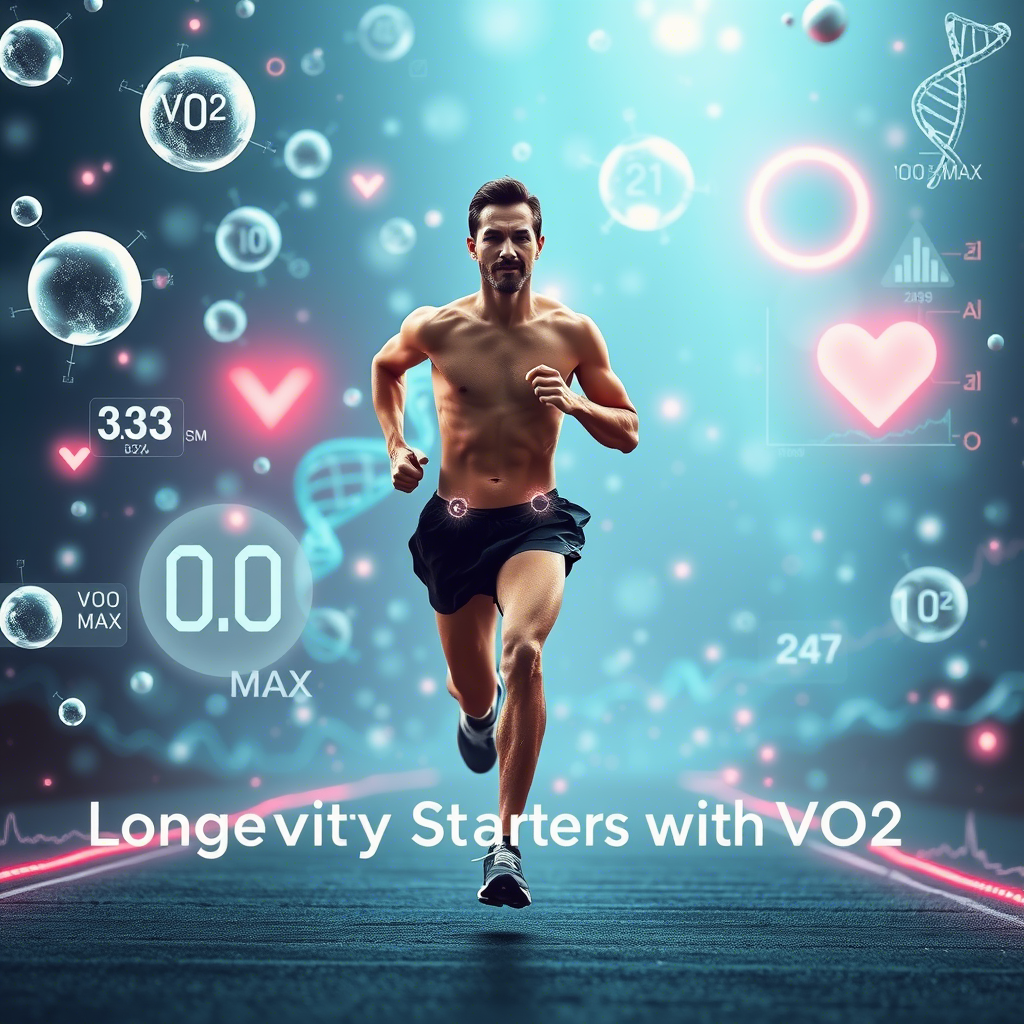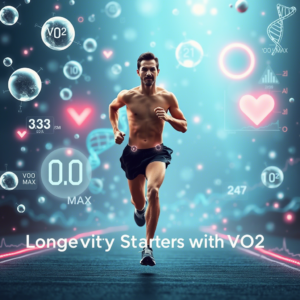Unlocking Vitality: What VO2 Max Says About Your Longevity & How to Biohack It
Introduction: Oxygen Is Life
Ever felt like you’re doing everything right—eating clean, staying active, managing stress—yet still lacking energy and vibrancy? The missing link may lie in a single, powerful biomarker: VO2 Max. It’s not just a number athletes care about—it’s a predictor of how well you age, how your body recovers, and even how long you might live.
In this in-depth guide, we’ll explore what VO2 Max is, why it matters for longevity and vitality, and the best ways to biohack it. By the end, you’ll have actionable tools and cutting-edge insights to start optimizing your cellular health immediately.
Section 1: What Is VO2 Max?
VO2 Max is a scientific measure that tells us how efficiently your body utilizes oxygen when you’re performing at maximum effort. Think of it as the engine capacity of your body’s aerobic system. The higher your VO2 Max, the more oxygen you can deliver to your muscles, and the better your physical performance and cellular energy production.
This metric is not only a gold standard for athletic endurance but also an essential indicator for anyone interested in healthspan and quality of life. It’s like a report card for your mitochondria—the powerhouses of your cells.
Tracking VO2 Max over time can give you real feedback on your cardiovascular health and fitness level. Whether you’re looking to boost performance, reverse signs of aging, or prevent disease, VO2 Max is a critical number to know.
- It reflects your aerobic capacity, cardiovascular efficiency, and mitochondrial performance.
- It’s considered a top biomarker of cardiorespiratory fitness, which correlates directly with longevity.
“VO2 Max is the single most powerful predictor of mortality and functional independence in older adults.” – American Heart Association
Section 2: What Does VO2 Max Reveal About Vitality & Longevity?
When you think of longevity, you might imagine supplements or gene editing. But the truth is far simpler: your ability to efficiently use oxygen is one of the most reliable indicators of how long—and how well—you’ll live. VO2 Max provides a window into your physiological resilience.
A high VO2 Max score reflects superior heart health, vascular flexibility, and mitochondrial efficiency. It signals that your body can adapt well to stress, recover faster, and delay the onset of age-related decline. Low VO2 Max, on the other hand, is a red flag that often correlates with chronic inflammation, sedentary habits, and higher biological age.
VO2 Max is also directly related to energy availability in the brain and muscles. If your score is low, you may experience fatigue, brain fog, and slower recovery from both physical and mental exertion.
High VO2 Max =
- Better energy production (ATP synthesis)
- Superior brain and heart function
- Increased resilience against disease
Low VO2 Max =
- Early fatigue
- Poor cognitive function
- Higher risk of cardiovascular events and premature aging
Studies (Harvard Health, JAMA, 2023) confirm that individuals in the top VO2 Max percentile live up to 5 years longer and suffer less chronic disease.
Section 3: How Is VO2 Max Measured?
Getting an accurate VO2 Max reading used to be the realm of elite athletes and clinical research. Today, it’s more accessible than ever thanks to wearables, smart algorithms, and functional medicine clinics. The key is choosing the right method based on your goals—whether that’s baseline tracking, performance optimization, or medical-grade precision.
The most precise measurements come from laboratory-based protocols using gas exchange analyzers. These tests push you to your physical limits while analyzing the oxygen and carbon dioxide levels in your breath in real-time. However, wearable tech has advanced significantly and now offers useful estimates for most people.
By combining both high-tech tools and practitioner insights, you can get a highly detailed snapshot of your current fitness and create a tailored strategy to improve it.
1. Lab-Based Testing (Gold Standard)
- Performed with a metabolic cart.
- Measures oxygen intake, carbon dioxide output while on a treadmill or bike.
- Highly accurate.
2. Wearables (Good for Tracking Trends)
- Devices: Garmin, Apple Watch, WHOOP.
- Estimate VO2 Max using heart rate, pace, and movement data.
- Useful for ongoing tracking, though ~10–20% margin of error.
Section 4: VO2 Max Thresholds: What’s a Good Score?
Knowing your VO2 Max is one thing—understanding what it means is another. This is where benchmarking comes into play. VO2 Max thresholds help you interpret your score in terms of risk level, vitality potential, and opportunities for optimization.
The table below outlines general ranges for VO2 Max scores based on overall population averages. Keep in mind that optimal levels vary by age, sex, and fitness goals. Still, aiming for higher tiers is always beneficial for long-term health.
Many people underestimate how much they can improve their VO2 Max with intentional training and lifestyle adjustments. Even modest gains (5–10%) can lead to measurable improvements in mood, cognition, energy, and recovery speed.
VO2 Max (ml/kg/min) | Fitness Level | Longevity Outlook |
|---|---|---|
<30 | Poor | Accelerated aging |
30–40 | Average | Baseline health |
40–50 | Good | Extended vitality |
50–60 | Excellent | Youthful aging |
>60 | Elite | Peak lifespan |
Section 5: How to Improve & Maintain High VO2 Max
Boosting your VO2 Max is less about magic pills and more about strategic lifestyle design. It’s a mix of exercise science, cellular nutrition, and recovery discipline. Anyone, regardless of starting point, can significantly raise their VO2 Max with focused effort.
This section outlines the core areas to target: mindset, movement, food, and supplementation. The goal is not just to increase VO2 Max temporarily, but to sustain high levels of oxygen efficiency long-term.
Remember, improvements may be gradual but consistent gains compound—especially when your approach is personalized and holistic.
🧠 Mindset & Habit Shift
- Adopt a growth mindset around physical and mental performance.
- Use breathwork (e.g., Wim Hof, oxygen advantage) to increase oxygen tolerance.
🏃♂️ Exercise Protocols
- Zone 2 Cardio (low-intensity steady state): 3–4x per week
- HIIT (High Intensity Interval Training): 2x per week
- VO2 Max Intervals: 30-second sprint / 90-second rest x 5 sets
🥦 Nutrition & Food Hacks
- Foods high in nitrates (beets, arugula)
- Rich in antioxidants (berries, turmeric)
- Mitochondrial support: CoQ10, Omega-3s, PQQ
💊 Supplementation
- NMN/NAD+ boosters – support cellular respiration
- Magnesium – critical for ATP function
- L-Citrulline – enhances nitric oxide and blood flow
- Cordyceps & Rhodiola – adaptogens that enhance oxygen efficiency
🧬 Advanced Biohacks
- Hyperbaric Oxygen Therapy (HBOT)
- Red Light Therapy (Photobiomodulation)
- Cold exposure + heat contrast
- Mitochondrial-targeted antioxidants (MitoQ, SkQ1)
Section 6: Recovery: How to Rebuild & Sustain VO2 Gains
Many people focus heavily on training but overlook recovery—the secret weapon for long-term performance. Without proper recovery, your gains are fragile and short-lived. Your nervous system, mitochondria, and hormones all need downtime to recalibrate and grow stronger.
VO2 Max improves most significantly when stress is cyclical: exert, rest, adapt, repeat. This section covers active recovery strategies that enhance VO2 retention and promote faster regeneration.
Investing in recovery is investing in your future resilience. These practices are particularly critical as you age, when recovery windows naturally lengthen.
Recovery is where your VO2 gains are locked in:
- Sleep Optimization: 7–9 hrs; track HRV to assess recovery
- Breath Training: CO2 tolerance tables, hypoxic training
- Active Recovery: walking, stretching, mobility drills
- Nervous System Balance: Vagus nerve stimulation, meditation
“You don’t grow during the workout—you grow during recovery.”
Section 7: Final Thoughts – Oxygen is the Language of Longevity
Oxygen is more than just air—it’s the core currency of biological vitality. VO2 Max tells us how fluent your body is in using that currency, and whether you’re building wealth (healthspan) or incurring debt (cellular stress).
Whether you’re an athlete, executive, or recovering from burnout, optimizing VO2 Max should be a central pillar in your vitality strategy. The tools and insights shared here are designed to empower you to take control of your health at the most fundamental level.
When you understand your VO2 Max and actively work to improve it, you’re not just adding years to your life—you’re adding life to your years.
✅ Ready to Unlock Your VO2 Potential?
Book your holistic performance & recovery session at Natoorales.com today. Let us test your biomarkers, assess your baseline, and build a plan to keep your vitality high—at any age.
References
- JAMA Cardiology, 2023. “Cardiorespiratory Fitness and Mortality.”
- Harvard Health Publishing, 2022. “What Your VO2 Max Says About Your Health.”
- American Heart Association. “VO2 Max and Functional Independence.”
- Dr. Peter Attia Podcast: VO2 Max as a Longevity Marker.
- PubMed: VO2 Max improvements and mitochondrial health.
Author: Natoorales Longevity Team
For appointments and biohacking support, visit natoorales.com
For appointments and biohacking support, visit natoorales.com


